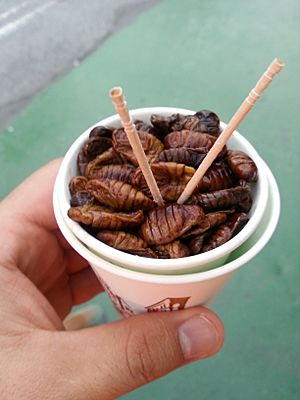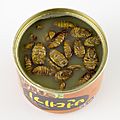Beondegi facts for kids
 |
|
| Course | Street food |
|---|---|
| Place of origin | Korea |
| Associated national cuisine | Korean cuisine |
| Main ingredients | Silkworm pupae |
| Similar dishes | Nhộng tằm |
| Korean name | |
| Hangul |
번데기
|
|---|---|
| Revised Romanization | beondegi |
| McCune–Reischauer | pŏndegi |
| IPA | [pʌn.de.ɡi] |
Beondegi (번데기) is a unique and popular Korean street food. The name "beondegi" literally means "pupa". This snack is made from silkworm pupae, which are the resting stage of the silkworm before it becomes a moth.
You can find beondegi sold by street vendors in Korea. It is usually boiled or steamed and served in small paper cups. People eat it using toothpick skewers. The smell of beondegi is often described as nutty, a bit like shrimp, or even like canned corn. Its texture is firm and chewy.
Sometimes, beondegi is served as a soup called beondegi-tang. This soup gets its flavor from ingredients like soy sauce, chili, garlic, green onions, and red pepper powder. It is often enjoyed as an anju, which means food eaten with drinks, especially in pubs.
If you want to try beondegi at home, you can find it canned in many supermarkets and convenience stores across Korea. Both the plain beondegi and the soup version are available.
The Story of Beondegi
Even though people in Korea have been raising silkworms for about 4,000 years, eating silkworm pupae is a more recent tradition. Silkworm pupae are a natural byproduct of the silk industry. People in silk farming villages started eating beondegi around the 1920s.
Beondegi became much more popular after the Korean War (1950-1953). During this time, the Korean government strongly supported the silk industry. Silkworm pupae became an important source of protein for many people. This was especially true during a time when food was scarce and poverty was widespread.
Gallery
See also
 In Spanish: Beondegi para niños
In Spanish: Beondegi para niños



